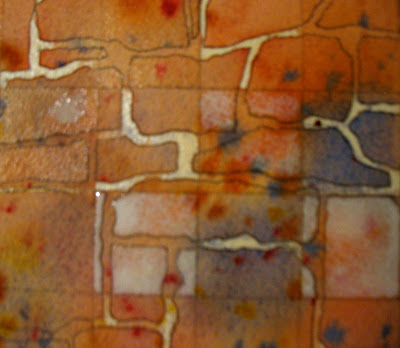We will use the cracks of a stone wall as a jumping-off point for this design . . .
For this project, you will need the following: watercolor paper and brushes, masking fluid, a quill pen or toothpicks and Q-tips (for the masking fluid) . . .
and four watercolor pigments (Quinacridone Burnt Orange, French Ultramarine Blue, Quinacridone Gold, and Permanent Alizarin Crimson). . .
Begin by drawing a grid on your watercolor paper, with a pencil and a ruler, resulting in 7 squares across and 10 squares down. . .
Now, either sit in front of a stone wall, or refer to the photograph above, and draw the cracks in the wall, with your pencil. No shading -- just draw the contour of the cracks you see. Ignore the grid -- just draw the cracks until you've covered your paper. . .
Now, prepare your masking fluid. In a small plastic container, pour in a little of the masking fluid. Add water to the masking fluid and mix it up with a toothpick. By watering it down, it makes the masking go on easier with a quill pen. I like to use a quill pen, because you can peel off the masking from the metal nib after it dries.
Draw the masking fluid on the cracks -- in EVERY OTHER SQUARE. . .
Allow the masking fluid to totally dry before proceeding.
Now, prep your paints on your palette -- the French Ultramarine, Alizarin Crimson, Burnt Orange, and Quin Gold.
Wet the entire painting with clear water, and drop in these four colors, in a random way, and let them mingle on their own. . .
While this is still damp, spatter these same colors onto your painting (just dip your brush in the pigment and then tap your brush over the wet paint -- your brush should not touch the painting) . . .
Now, let your painting dry, on a flat surface.
You will be doing some more masking, so be sure that your painting is completely dry.
Mix up some more masking fluid and water in your small plastic container.
This time, apply the masking fluid to those squares that you skipped last time. But, in those squares, instead of masking the cracks, you will MASK THE AREAS AROUND THE CRACKS . . . in EVERY OTHER SQUARE. . .
When you have larger areas to cover with the masking, outline the shape with the quill pen, dipped in masking, and fill it in with a Q-tip dipped in masking.
So, each square is the opposite of the square next to it . . .
Let this dry completely. Meanwhile, mix up a few puddles of darks: French Ultramarine + Burnt Orange; Burnt Orange + Alizarin Crimson; and, Alizarin Crimson + French Ultramarine . . .
Now, WITHOUT wetting your paper first, start painting these darks on a diagonal, one at a time -- working your way down the paper. When you switch colors, rinse out your brush quickly, pick up the next color, and start painting where you left off . . .
While this is still wet, spatter some individual colors onto it -- Fr. Ultramarine, Aliz. Crimson, and Bt. Orange. Now, let this dry completely.
Now, it's time to remove all the masking from your painting. To do this, you can use a rubber cement pick-up eraser -- just rub it off gently. If you don't have one of these erasers, you can use your thumb or a kneaded eraser.
When you've picked up/ rubbed off all of the masking, rub your hand over the surface of the painting to make sure that you've gotten it all off.
You are almost, but not quite, finished.
Mix up a pale wash of Quinacridone Gold -- lots of water with a little pigment. Now, paint this wash over the outer squares only -- all the way around. This is called "glazing" -- where you paint a pale wash over layers of dry paint.
OK -- NOW you're done! Just sign, mat, and frame it -- it would look awesome with a big, wide white mat around it, in a simple black frame.




















No comments:
Post a Comment